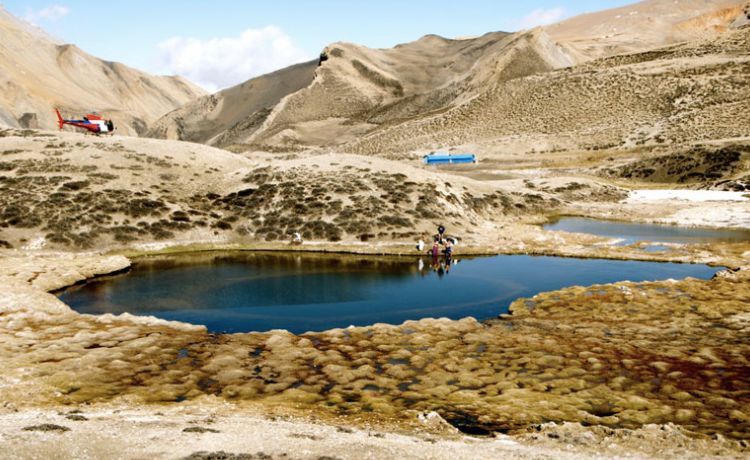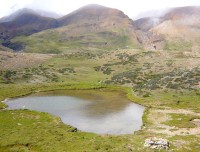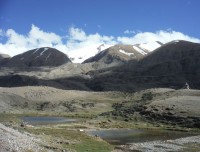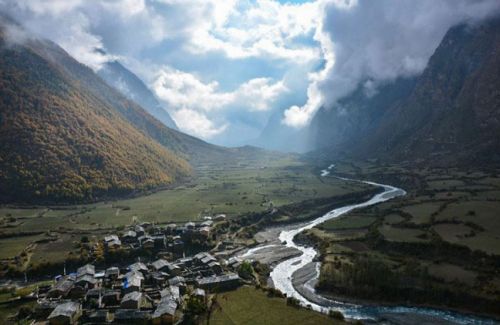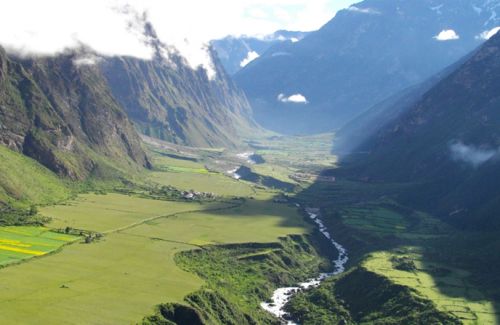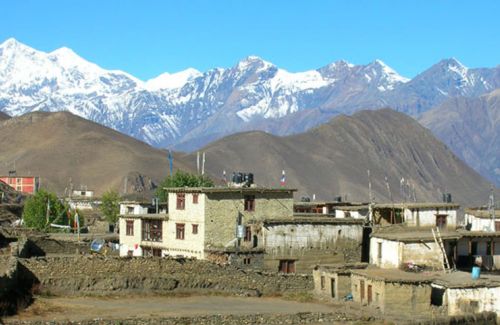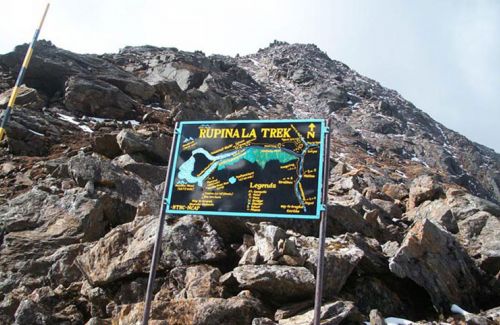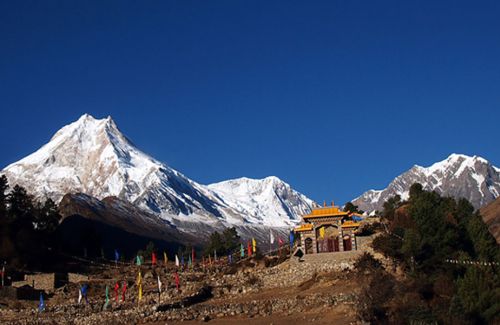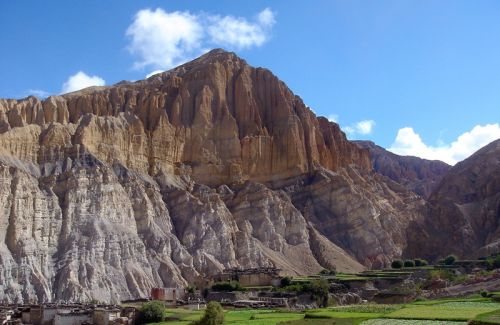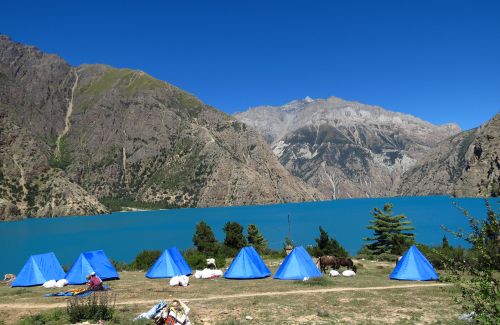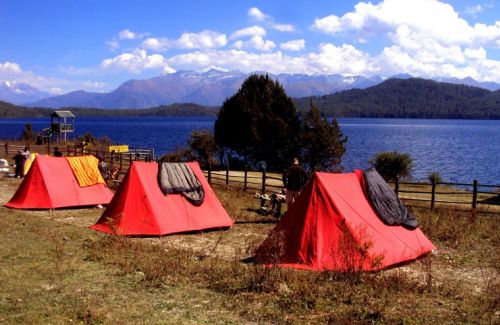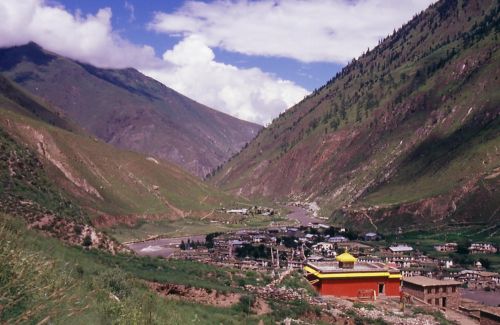Damodar Kunda Trekking
- Duration20 Days
- Max. Altitude5,400 m
- Starts FromUSD 2420
Destination:Nepal
Trip Grade:Strenuous (****)
Meals:Breakfast + Lunch + Dinner
Transportation:Private Vehicle / Aeroplane
Accommodation:Camping
Trip Route:Pokhara – Jomsom – Lo Mangthang – Damodar Kunda - Muktinath- Jomsom
Show AllDamodar Kunda Trekking is one of the holiest lakes of all Hindus as well as Buddhists. The word ‘Kunda’ represents Lake. Damodar Kunda is located in Mustang district at mid western Nepal. This area is very close to Nepal Tibet border. Lying at an altitude of 5,400 meters, Damodar Kunda Trek carries wonderful natural beauty. The Gandaki River, a major Himalayan river originates from this holy lake. The most of the part of the trek Damodar Kunda lies in rain shadow area. So, trek Damodar Kunda is to experience unique barren landscape with its low vegetation. While trekking Damodar Kunda, we encounter coldness with sandy wind.
We start this trekking from Jomsom following the route of Upper Mustang trail. After we get to Lomanthang, we acclimatize there for a day. Then we proceed to north east. From Lomanthang it takes three days to arrive Damodar Kunda. From this sacred lake we see the Tibetan plateau & Damodar Himal to the north and the Annapurna Himalayan massiff to the south. Damodar Himal is a mountain range. It Includes Muktinath Himal (6,706m), Bhrikuti Peak (6,364m), Chuungian Chanma Himal (6,165m), Mustang Himal (6,623m), Araniko Chuli (6,034m) and other mountain peaks. On every full moon day of August a big festival occurs around this lake. The best time of this trekking is from April to September. We have elaborative Damodar Kunda Trekking Itinerary which can be customized.
Trip Highlights
- Sightseeing at World Heritage Sites in Kathmandu
- Scenic drive from Kathmandu tp Pokhara and back to Kathmandu
- Excitng flight over the mountains from Pokhara - Jomsom - Pokhara
- Holy Damodar-Kunda lake at an altitude of 5,400 m
- Mystic landscape having low vegetation
- Amazing rain shadow area where there is no rainfall even in monsoon
- Superb panorama of Annapurna range, Damodar Himal, Muktinath Himal and Bhrikuti Peak
- Visit Lo-Mangthang, the capital of Mustang kingdom, the major destination of Upper Mustang trek
- Spectacular caves in the cliffs, Buddhist monasteries, ruined forts and chortens at Lo-Mangthang
- Ancient and isolated villages
- Enjoy the view of Tibetan Plateau
Day to Day Itinerary
Day 01:Arrival in Kathmandu (1,350 m) and Transfer to the Hotel. O/N at Hotel
Day 02:Kathmandu Sightseeing and Trek Preparation. O/N at Hotel
Day 03:Drive from Kathmandu to Pokhara (827 m), 7 hrs bus. O/N at Hotel
Day 04:Fly from Pokhara to Jomsom then trek to Kagbeni (2,800 m), 4 hrs. O/N at Tented Camp
Day 05:Trek from Kagbeni to Chele (3,100 m), 6 hrs. O/N at Tented Camp
Day 06:Trek from Chele to Syangboche (3,800 m), 7 hrs. O/N at Tented Camp
Day 07:Trek from Syangboche to Tsarang (3,800 m),7 hrs. O/N at Tented Camp
Day 08:Trek from Tsarang to Lo- Mangthang (3,840 m), 4 hrs. O/N at Tented Camp
Day 09:Exploration Day at Lo- Mangthang. O/N at Tented Camp
Day 10:Trek from Lo- Mangthang to Yara (3900 m), 6 hrs. O/N at Tented Camp
Day 11:Trek from Yara to Ghuma Thanti (4890 m), 7 hrs. O/N at Tented Camp
Day 12:Trek from Ghuma Thanti to Damodar Kunda (5,400 m), 10 hrs. O/N at Tented Camp
Day 13:Trek from Damodar kunda to Ghuma Thanti (4,800 m), 8 hrs. O/N at Tented Camp
Day 14:Trek from Ghuma Thanti to Yara (3,900 m), 7 hrs. O/N at Tented Camp
Day 15:Trek from Yara to Tangye (3,240 m), 7 hrs. O/N at Tented Camp
Day 16:Trek from Tangye to Tetang (3,040 m), 9 hrs. O/N at Tented Camp
Day 17:Trek from Tetang to Muktinath (3,700 m), 6 hrs. O/N at Tented Camp
Day 18:Trek from Muktinath to Jomsom (2,750 m), 5 hrs. O/N at Tented Camp
Day 19:Fly back to Pokhara from Jomsom and from Pokhara to Kathmandu. O/N at Hotel
Day 20:Departure to International Airport
Cost Include
- Airport picks up & drops by private tourist vehicle
- A Guided city tour by private tourist vehicle
- A government licensed holder city tour guide
- Drive from Kathmandu - Pokhara - Kathmandu by Tourist Coach
- Fly from Pokhara to Jomsom and Jomsom to Pokhara
- 3 nights twin sharing 2-3 star hotel in Kathmandu and 2 nights in Pokhara with Breakfast
- Guided city tour in Kathmandu by private tourist vehicle
- Full Board Meals (Breakfast + Lunch + Dinner) during the trek
- Tented Camp basis accommodation during the trek
- Professional license holder English speaking Trekking Guide
- The required number of local staff and porters (2 Trekkers = 1 Porter)
- Food, accommodation, salary, insurance, equipment and medicine for all staff
- Annapurna Conservation Area Entry Permit
- Damodar Kunda Special Permit and TIMS permit for the trekking
- Down Jacket, Duffle bag and sleeping bag by Himkala Adventure if required
- Farewell dinner in traditional Nepali Restaurant with typical Nepali Cultural Show
- Government taxes, vat & service charges
Cost Exclude
- Lunch and dinner whilst in Kathmandu and Pokhara
- Entrance fee in all monuments during tour in Kathmandu
- Emergency Rescue and Evacuation cost
- Your travel insurance
- Nepal Entry Visa fee
- Any types of Bottled Drinks, Phone Bills, Laundry Services etc
- Personal trekking equipment
- Tips for trekking, tour staff and driver (Tipping is expected)
-
Any others expenses which are not mentioned on ‘Cost Includes' section
Detail Itinerary
Day 01Arrival in Kathmandu (1,350 m) and Transfer to the Hotel. O/N at HotelUpon your arrival at Tribhuvan International Airport in Kathmandu, Nepal, our representative from Himkala Adventure greets you and transfers to hotel at Thamel. You could take rest or walk around Thamel in your leisure. Overnight at Kathmandu
Day 02Kathmandu Sightseeing and Trek Preparation. O/N at Hotel After breakfast, we begin our day tour around 9 am heading towards Swoyambhu, the monkey temple. It is 3 km far from Thamel and situated in the conical shaped hill. This is lovingly called the monkeys temple because there are about 460 monkeys in the hill wandering here and there. This is the place mostly influenced by the Bajrayana followers, often visited by the Newar people of Kathmandu and the visitors from out of Valley. After this, we descend down to Kathmandu Durbar Square, where we can differentiate two different architectures in the same place i.e. one is old one from the early 18th century and the other one is the neoclassical. There are many Hindu temples and courtyards to be visited. One of them is the Nasal Chowk, was famous for the King’s coronation. We move from here to Boudhanath Stupa and Pashupatinath then return back to hotel and brief you about the Damodar Kunda trekking. Overnight at Kathmandu
Day 03Drive from Kathmandu to Pokhara (827 m), 7 hrs bus. O/N at Hotel We can drive from Kathmandu to Pokhara by Prithivi Highway. This is smooth well pitched road passing through scenic spot from the bank of popular Trishuli River – a rafting destination for the beginners and of mild rafts. This is 200 km west from Kathmandu. The bus ride through rural areas and terraced cultivable land would be great. If we fly from Kathmandu to Pokhara, it is half an hour flight over the beautiful range of mountains. Overnight at Pokhara
Day 04Fly from Pokhara to Jomsom then trek to Kagbeni (2,800 m), 4 hrs. O/N at Tented Camp Today, we fly from Pokhara to Jomsom. It is short and easy 20 minutes flight to Jomsom. Jomsom is situated on the bank of Kali Gandaki River famous for the gate way to the holy site of Muktinath. Daily morning flights are operated by Nepal Airlines, Tara Airlines and Simrik Airlines. From Jomsom, we trek to Kagbeni heading to northeast on the west side of the Kali Gandaki. We go upstream and reach to the trail junction of Ekali Bhatti. The left fork up the river to Kagbeni is after half an hour walk. Overnight at Kagbeni
Day 05Trek from Kagbeni to Chele (3,100 m), 6 hrs. O/N at Tented Camp After breakfast, we check our restricted area permit and head towards Upper Mustang. We follow the left bank of Kali Gandaki River which rises up and falls down. We cross a small stream and ascend up to the terraced hill and reach to Tangye. We get lunch here and comtinue our trek to Chhusang village. From Chhusang village, we go upstream of Kali Gandaki. We cross the iron bridge and climb up to the terrace and arrive at Chele. Overnight at Chele
Day 06Trek from Chele to Syangboche (3,800 m), 7 hrs. O/N at Tented Camp After breakfast, we leave Chele and climb up through the rough road to the Plateau. We further ascendthe gentle slope and enter the big canyon. We follow the trail that cuts out of the cliff and reach to the small pass. We begin to descend slightly to reach to Samar village encircled by a poplar grove. We take a lunch there and again descend down to the stream, after this, we climb up and descend to another stream. We arrive at the plateau. We keep on climbing from the right fork to the Chungsi La and reach to Ranchung cave. After the cave, we climb gradually to Syangboche passing the pastureland. Overnight at Syangboche
Day 07Trek from Syangboche to Tsarang (3,800 m),7 hrs. O/N at Tented Camp Today, we climb up to the small pass and continue to descend to Ghiling. We cross the stream and go through the farmlands. We walk through the big village and ascend gently to Nyi La. After crossing the Pass, we enter the center of Mustang which is known as the Lho region. We descend the mild slope and contour the valley to the left. The trail fluctuates and reaches to the village where we take lunch. After lunch, we cross the suspension bridge and climb to the terraced field and pass along the Mani wall in Mustang. The trail goes steep through rocky ditch and traverses to Tsarang. We further descend down to Tsarang village where there is a big chorten in the entrance of the village. Overnight at Tsarang
Day 08Trek from Tsarang to Lo- Mangthang (3,840 m), 4 hrs. O/N at Tented Camp After breakfast, we visit the old palace and ancient Buddhist monastery then we descend to the gorge of the Tsarang Khola. We go upstream and cross an iron bridge over the river. We climb through the rocky ditch and enter to the valley by dirt road that turns north and climb gently to the big isolated chorten which separates Tsarang and Lo-Mangthang. After crossing the stream, the trail widens and goes through the desert like landscape and reach to Lo-La. We descend to the stream and climb to the plateau of Lo-Mangthang. Overnight at Lo-Mangthang
Day 09Exploration Day at Lo- Mangthang. O/N at Tented Camp It is the day to explore Lo-Mangthang Valley, visit monastery and walk around the villages. We head towards eastern valley of Lo-Mangthang first. There is the place called Chhoser and we can see Garphu and Nyaphu Gompas. This is the main trading route of Lhasa. We descend to the stream, cross the wooden bridge, climb to reach Garphu and Nyaphu Village. We visit the monastery inside the cliff and caves. After this, we return back to our camp. Overnight at Lo-Mangthang
Day 10Trek from Lo- Mangthang to Yara (3900 m), 6 hrs. O/N at Tented Camp After breakfast, we ascend until we reach Day-La with dusty trail. We continue the trail; follow the left fork to reach Tsarang. The trail smoothly goes up to the ridge and cross the small pass then we descend down to wide plateau. After this, we further descend through rocky channel to reach to Dhi Village. We take lunch there. After lunch, we cross the bridge over the Kaligandaki River and make a short steep climb. We follow along the Puyung Khola upstream and reach to Yara Village. Overnight at Yara
Day 11Trek from Yara to Ghuma Thanti (4890 m), 7 hrs. O/N at Tented Camp After breakfast, we climb up to reach Luri Cave Monastery. We can take some time to explore this monastery and follow the barren valley. We take our lunch on the way and continue our trek to cross the pass situated at an elevation of 5,100 m. Overnight at Ghuma Thanti
Day 12Trek from Ghuma Thanti to Damodar Kunda (5,400 m), 10 hrs. O/N at Tented Camp After breakfast, we again follow the fluctuating trail. We cross the high altitude pass at an elevation of 5,600 m and reach to Damodar Kunda. Overnight at Damodar Kunda
Day 13Trek from Damodar kunda to Ghuma Thanti (4,800 m), 8 hrs. O/N at Tented Camp After breakfast, we retrace back all the way passing over the high pass. Then, the trail goes up and down Bas Khola where we can have our packed lunch and continue to Ghuma Thanti. Overnight at Ghuma Thanti
Day 14Trek from Ghuma Thanti to Yara (3,900 m), 7 hrs. O/N at Tented Camp After breakfast, we continue the same route which we climbed up before. Then, we continue downhill to reach to Yara Village. We take our lunch on the way. Overnight at Yara
Day 15Trek from Yara to Tangye (3,240 m), 7 hrs. O/N at Tented Camp We begin our trek early in the morning. First we climb steep and follow the flat trail. The flat trail descends down until we reach Dechhyang Khola, originated from Damodar Kunda. It takes half an hour to reach there. We find ammonite fossils (Black Stone, known as Shaligram) everywhere. Then we climb and head towards the top of the pass. We can have lunch there on the top and continue the trek going up and down through the big plateau which finally reaches to Tangye. Overnight at Tangye
Day 16Trek from Tangye to Tetang (3,040 m), 9 hrs. O/N at Tented Camp Today is an exhausting day but we have to be energetic and begin our trek. After breakfast, we cross the bridge and follow the trail going along the river. We cross the river and climb up to reach the small pass. The trail goes straight to the shelter house and we get lunch there. After lunch, we cross the small passes and reach to the top of the hill after 2 hous from the shelter house. We descend steep way to Tetang Village. Overnight at Tetang
Day 17Trek from Tetang to Muktinath (3,700 m), 6 hrs. O/N at Tented Camp We follow the path through village after passing Mani walls. We climb up the wide valley and ascend until we reach to small pass. We drop down to the small stream and cross the suspension bridge and enter into the Chhyongar Village. We follow the same trail till Muktinath passing Kani/ Gate. There are many things to explore like 108 water spouts, Muktinath Temple, An eternal Flame, Jwala Mai Temple, Holy Shila etc. Overnight at Muktinath
Day 18Trek from Muktinath to Jomsom (2,750 m), 5 hrs. O/N at Tented Camp After breakfast, we leave Muktinath and drop down to Jharkot Village. We can visit old Shakyamuni Monastery and Traditional Medical Center.We follow the dusty road for a while and go through the left trail and arrive at Ekali Bhatti. We take our lunch there and again follow the dusty road along the Kali Gandaki River to reach to Jomsom. Overnight at Jomsom
Day 19Fly back to Pokhara from Jomsom and from Pokhara to Kathmandu. O/N at Hotel After the trek from Muktinath to Jomsom, we rejuvenate in Jomsom and fly in the morning to Pokhara. This is 20 minutes flight to Pokhara and we wait for another flight to Kathmandu. The second flight of half an hour from Pokhara to Kathmandu is exciting too. After we land, we drive to hotel and spend time as we wish. There is a dinner organized by Himkala Adventure in the typical Nepalese restaurant with Nepali Cultural Show. Overnight at Kathmandu
Day 20Departure to International Airport We depart you 3 hours before your scheduled flight in the Tribhuvan International Airport. Your trip ends with unforgettable moments of the Damodar Kunda trekking and flying back to your sweet home or the next destination. With our warm gratitude that you joined Himkala Adventure, we say bye and leave you in the departure entrance. We wish you for the safe journey ahead. Namaste!!!
Trip FAQ
Himkala Adventure would like to quench the thirst of all necessary questions answers about Damodar KundaTrekking for all curious travelers/trekkers in the world. As you are entirely from different geographical location, you could better to know everything about the treks from the beginning i.e. airport pick up till your departure like airport picks up, drops off, accommodation in city, in the trek, guide and porters, safety for the trekking, food and accommodation and some other things that you might face on the way. Hope our endeavor listing these questions answers will help you self informed.
This is simply the outlines of the services we offer but it may differ as per your requirement, number of trekkers. What we go through our conversation, we will manage the means of transportation, hotels in the city, accommodation in the trekking, numbers of porters etc. This is general idea about Damodar Kunda Trekking before your trip and you become clearer about the trek. Please feel free to contact us to get more information about the trekking in the Himalayas of Nepal.
1) How is Damodar Kunda Trekking in Nepal?
Damodar Kunda is the holy lake, situated in north of Annapurna range. It is situated at the height of 5400 m from the sea level. Damodar Kunda trek has opened for tourist since 2002 for all trekkers and foreigners.It is cold and windy place. It is fully supported camping trekking.
2) What physical fitness do I need to book this trip?
Every trekking in the Himalayas of Nepal require the certain level of physical and mental fitness.So, we advise you to be in good physical shape and able to feel comfortable while hiking up and down 7 to 12 miles per day on a trail carrying a day pack of about 10 pounds. Three things could make you confident enough for any trek you would like to do: aerobic, strength and mental.
Aerobic conditioning is important primarily because you will be trekking in thinner air, up to 40% less than at sea level. With good aerobic conditioning, you will be able to better metabolize whatever oxygen is available to you. You should plan on doing at least one hour of aerobic 3 /4 times per week for 1 month or more before your arrival in Nepal. Walking, jogging, cycling, hiking on valley floor to ridge line ascents with day back are some of the excellent forms of exercise, so long as you are strengthening leg muscles and building stamina. Speed is not the essence; stamina, confidence and continuity are.
3) How do I find Himkala Adventure for my pick up at the airport?
Our representative from Himkala Adventure will display a small board of company or with your name outside the airport terminal. You will be driven to the hotel by our tourist vehicle.
4) What sort of accommodation do I get in Kathmandu?
Normally we provide standard rooms with twin sharing accommodations at three star or similar category hotels in Kathmandu including breakfast. Accommodation in these cities can be upgraded as per your request. But some of our packages are sold without accommodation in the city.
5) How is camping trek during Damodar Kunda Trekking?
Camping trek to Damodar Kunda is fully organized and supported, with a team of guides, cooks, and porters to accompany you. Our porters carry all the trekking gear, food, fuel and personal belongings. Our cooks prepare hot meals. Trekkers need only carry a small bag as required for the day. At night, tents for dining, sleeping and ablutions tents are provided and set up, also mattresses and down-filled sleeping bags, tables and seating.
In a typical camping trek, we start the day around 6 a.m. with a cup of hot tea. You are then provided with a bowl of warm water for washing. Then trekkers enjoy breakfast before leaving camp. The trek begins around 7.30 - 8 a.m.Trekkers can set their pace for pausing and sightseeing and the walk to the lunch spot will normally take 3 hours. On arrival, you are served hot lunch. In the afternoon, after walking for another 3 to 4 hours, you arrive at the next camp around 5 p.m. Tea & snacks are served while our staff readies the camp. Dinner time is around 6/7 p.m. in the dining tent, lit with lanterns and comfortably furnished. The food is healthy, wholesome and hygienically prepared.
6) What mode of transportation do I use?
We will provide the private transportation for Airport/Hotel/Airport pick up and drop and sightseeing in Kathmandu Valley. We use transportation as based on our cost inclusion section. The transportation varies depending on your requirements at the time of booking the trip.
7) What is the best season for this trekking?
The best season for Damodar Kunda Trekking is spring (March to May) and autumn (September to December). These are the perfect time of the year for the breathtaking views of Himalayas with clear and sunny days. But the weather in the mountains is unpredictable.
8) What is the weather and temperature like during the trekking?
The climate in Nepal varies from place to place which can be categorized in different four main seasons. The main seasons in Nepal are spring (March to May), summer (June to August), autumn (September to November) & winter (December to February). The best season to travel in Nepal is autumn (September, October & November) & spring (March, April & May). Weather in the mountains is unpredictable. But the day temperature in Damodar Kunda Trekking is comfortable.
9) Who will be guiding me during this trip?
We provide the professional government license holder English speaking trekking guides for our entire trekking trip. We can also provide French, Spanish, Japanese, German or Italian speaking guides as per your preference with extra payment but not guaranteed. All guides will be Nepali people who are carefully selected on the basis of their appropriate experience, leadership skills and personality. They are all trained from Nepal Academy of Tourism and Hotel Management, certified and approved by the Tourism Department of Nepal government. We provide a different city tour guide to guide you in UNESCO World Heritage Sites in Kathmandu. They are the professional license holder guide specialized in culture, history, geography, iconography, archeology and religion with good command over English. Tour guides are specialized in city tour and trekking guides are more in the hiking and trekking in the Himalayas.
10) What sort of experience do your guides have?
Our entire city tour guides have bachelors to Master Degree academic education along with many months tour guiding training from Nepal Academy of Tourism and Hotel Management, Rabi Bhawan, Kathmandu, Nepal. They are fluent in spoken languages and informative about the sites in many aspects. They are quite experienced and dedicated to their job and responsibilities.
Our entire trekking guides have minimum Intermediate to Master Degree academic education with trekking guide training from Nepal Academy of Tourism and Hotel Management, Rabi Bhawan, Kathmandu, Nepal. Many of them are from villages. As they are local, they know more about the routes, necessary precaution to be taken and so on. They have spent many years exploring many parts of the country. They are trained in first aid and able to handle any situation easily. They speak good English and make you know about the places you visit.
11) May I charge my electronic devices during Damodar Kunda Trekking?
This is fully camping trek, so we may not be nearby any settlements. You could better manange extra battery or any other alternatives.
12) What is the social and environmental responsibility of Himkala Adventure for this trip?
The situation of environment in Nepal is in considerable stage due to so many factors caused by global warming, human activities, and adverse effects of natural incidents. Nepal is in between two giant countries like China and Nepal. The ozone layer is depleting and the atmosphere is getting heated. So, its direct effect is to the Himalayas that the snow is melting day by day and the sea level is rising. It is due to population growth, people are clearing the forest and the soil is being eroded. As a part of society, and our trekking related activities are directly concerned with the social and environmental things. We are very conscious not litter in the open spaces, to manage garbage properly and make local people aware in this campaign. We are working together with other companies and taking these issues seriously.
13) What is the minimum number requirement for this trip?
We operate individual trip to the group joining trips for Damodar Kunda Trekking. If you want to do any private trip we are ready to organize for solo traveler as well with some additional charges.
14) Are there communication or internet services during Damodar Kunda Trekking?
We highly recommend taking local SIM card for call and internet services during trekking. Local SIM cards are easily available in many stores and at airport as well. You need to provide two copies of your photographs and your passport copy to get local SIM CARDS of NCELL & NTC (only these two companies provide telephone services in Nepal
15) May I add extra days in trekking?
We are ready to operate your holidays as per your interest and requirements. You can spend extra days on your loving or favorable places or even can make it shorter. We will always do our best to manage your hotel bookings, flight booking and everything.
16) What happens in case of emergency?
Himkala Adventure has prepared for any emergency situation and knows how to handle it. Our guides are trained in first aid and can deal with most of the basic ailments that occur during the trek. Every client should have his own insurance before coming to Nepal for the case of emergency.
17) Do I need to have insurance for this trip?
We request you to have a travel-insurance policy to cover theft, loss, medical problem & emergency helicopter evacuation from high altitude places before coming Nepal. Choose a policy to cover your emergency high altitude helicopter evacuation with all medical insurances for trekking in high altitude in the Himalayas of Nepal. Your travel insurance is always needed before going in any high altitude trekking. Please check your travel insurance policy which doesn’t exclude mountaineering or alpinism. Although you will not be engaging in these activities in your trekking, you might have problem convincing the insurance company of this fact. Rescue insurance need to cover an emergency helicopter evacuation or a charted flight from remote mountain trails of Nepal as well as international medical evacuation. A helicopter evacuation might cost US$ 2500 to US$10000 depending on the places. So that travel insurance to cover all above is must to travel in the high Himalayas of Nepal
18) What type of shoes should I wear during Damodar Kunda Trekking?
You could better have carefully chosen hiking boots with extra laces and camp shoes, which should be kind of strong, well-made but light boots for Damodar Kunda Trekking. Shoes and boots are best to buy before arriving in Nepal. We advise you to wear your new shoes for sometime before trek so that you could feel well habituated on the newer trail for your feet.
19) Can I use credit cards in Damodar Kunda Trekking?
Of course not, you can use only in the cities like Kathmandu, Pokhara but not in Damodar Kunda Trekking route. When you are out of city, all you need is cash, better to have small notes. Please change the currency in local Nepali rupees before you go to the mountains.
20) Do I need to tip my guide and porter? How much would that be?
Tipping is not mandatory, neither it is right to ask by anyone but it is a way of showing gratitude after taking service. The level of tip also shows how satisfy you are from the team that you had been during your tour/trek.However, we recommend you to spend minimum 10% of your total trip cost for tipping entire local staffs, the ratio of tipping guide and porter will be given to you at the pre-trip meeting in Kathmandu before starting the trek.
Trip Note
Cost:
The cost of trip varies according to the number of travelers in the group, the category of the Hotel, mode of the transportation and any kind of changes (if there is). So, if you would let us know all of these above mentioned things, then we could quote you the exact price.
Walking Trails:
There are stone steps up and down in most of the trekking routes in Annapurna Region. So, you might find a pair of trekking poles very useful.
Weather:
The main trekking season in Nepal is from October to December and March to May. The day temperature for walking in Damodar Kunda Trekking is comfortable. The sky is clear although there is snow and rainfall occasionally. It is about 10 degree centigrade at the height of 3,600 m and increasingly lower, the higher we go. There may be snow at Annapurna Base Camp at any time of the year.
Nepal Strikes:
There is much more progress in the political scenario in Nepal and we assure you that travelling in Nepal is safe. But there may be Bandha (wide transport strikes) at a very short notice. The shuttle bus is in operation by Nepal Tourism Board and the Nepal Tourist Police in conjunction with the Himalayan Rescue Association from domestic and international terminal to the various hotels in Kathmandu. The service costs 300 rupees per person.
Itinerary Disclaimer:
Himkala has thoughtfully designed all the itineraries but our itineraries are updated for the betterment on the basis of our past travelers’ comments and our own research. In case you find changes in the itinerary you printed and the upgraded one does not affect your trip. Please note that some changes may occur in our itineraries due to bad weather and common seasonal changes to timetables and transport routes.
Physical Rating:
Your trip will be meaningful if you could find yourself fit and fine. You will be walking up to 5,400 m from the sea level. As the geographical region varies, there is a temperature variation as well. So, we advise you to undertake regular physical exercise, jogging, hiking, riding, ascending and descending the long stairs etc.Precautions and acclimatization are undertaken but be aware of the effects altitudes can have.
Group Size:
Himkala Adventure organizes solo to group travelers. Our group trips are designed for sharing accommodation and there is no single supplement. Single travelers share with the same gender from twin to multi-share in an accommodation. You are requested to have mutual understanding in between the fellow travelers who have joined from the different parts of the world. Please remember that you have great responsibilities in the group. If you are requested to be at a particular place at a certain time, make sure that you have been there at a time. It is much more pleasing sharing experiences and traveling together.
Accommodation and Meals:
Accommodation and Foods in the Himalayan region of Nepal cannot be compared with any developed countries in the world. We know that you might not have experienced such things before but you should take it easy. Accommodations at local lodges are simple but clean and comfortable. The food is plain. Toilets and washing facilities are shared and rudimentary. In high altitude regions, there are very few tea houses and one has to be happy to share in simple dormitories without electricity, without running water. Hot shower means a bucket of hot water upon our request.
Money Matters:
Please note that most establishments in Asia will not accept foreign currency notes that are old, torn or faded and they can be very difficult to exchange or extra fees added when exchanging at banks. Please ensure that you have new, clean notes.
The official currency of Nepal is the Nepali Rupee (NPR). ATMs can be found only in major cities of Nepal like Kathmandu, Pokhara, Chitwan, Bhaktapur etc. The government of Nepal has banned the import, export and use of 500 and 1000 Indian rupee notes in Nepal. You make sure that you won’t carry these notes upon arrival in Nepal, otherwise they are confiscated and you may be fined.
Please make sure that the foreign currency notes that you have are new and clean notes because old, torn or faded foreign currency notes in Nepal are very difficult to exchange or extra fees added when exchanging at banks.
While travelers cheques have security advantages exchanging them can be a lengthy process, commissions can be high (up to 10%) and they can be difficult to change in rural areas, on weekends and public holidays. If you choose to bring travelers’ cheques, make sure they are a major brand and major currency.
Tipping:
Tipping is not mandatory. It is not anyone’s right asking for tips but if you are happy with the service, you could tip the staffs. It is entirely a personal preference. Tipping could be significant to them who took take great care of you in your traveling period. Himkala recommends that you could tip any intended recipient by any member of the group than collected and passed on by the group leader.
Note: Please do not tip with coins or dirty and ripped notes. This is culturally taken as an insult.
Local Dress in Nepal:
Nudity is a sensitive issue in Nepal. Women should avoid wearing shorts and sleeveless tops in public places where this might be seen as inappropriate. Remove shoes before entering certain holy places. Non-Hindus are not permitted in some temples.
Feedback:
Your feedback will be the great guidance to meet our target and to bring improvement in our service. What and how have you experienced with Himkala Adventure and our staff? Please write, we will read it carefully. One cannot see his/her shortcomings that are lying with them. Someone should point it out. We are always eager to hear from you.
